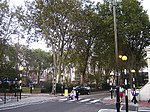Pathway was a North London 8-track studio at 2a Grosvenor Avenue, Newington Green, founded by producers Peter Ker and Mike Finesilver and later run by Finesilver until the mid-1990s. Among the artists who made their early recordings with producer Nick Lowe at Pathway Studios are The Damned, Madness, Elvis Costello, The Police, Squeeze, Haircut One Hundred, The Count Bishops with Mike Spenser, The Cannibals and John Foxx. At the studio, Dire Straits recorded the demo and single versions of "Sultans of Swing", and the folk singer Ewan MacColl recorded his last album.
Peter Ker and Mike Finesilver won a court case for a co-songwriting credit on Arthur Brown's Fire.
The Damned recorded their debut single "New Rose" at Pathway in September 1976, produced by Lowe. Sham 69 also recorded their first single "I Don't Wanna" in 1977, produced by John Cale. Pathway was featured in the Madness drama-documentary Take It or Leave It.Tim Crowther described it thus:
"The studio was very small, about 8 x 8 metres with a 2 x 2m control booth in the corner and an upright piano next to it. You could just squeeze three people into the control booth! The tape deck was a Brenell 1 inch 8 track. The monitors and desk were custom made, and they had a pair of Auratones as well, fed from Quad power amps. The desk was quite small, pushed hard against the front wall with the custom monitors hung above and the Auratones on the meter bridge. Outboard was very basic: a Bel delay line, an Alesis digital reverb and Drawmer gates, but they had a nice plate reverb in a cupboard in the office upstairs. I can't recall all the mics but they were the industry standard stuff. We got big warm sounding mixes and despite the cramped conditions the mixing process seemed effortless compared to the difficult digital learning curve I have been on in the last two years."
Mark Bedford of Madness recalls that "It was a really thin building - you couldn't really call it a house - on Grosvenor Avenue, close to Stoke Newington. The studio and control room were on the ground floor, then these rickety old stairs led to the office up top. The studio had that old-fashioned aerated board with the holes on the walls, so it was very fifties." Lee Thompson of Madness recalls that "It was just down a cobbled back alley. Unassuming, nothing flash, nothing big; just an oversized garage with a couple of speakers and soundproofed rooms. It was very rough and ready."








